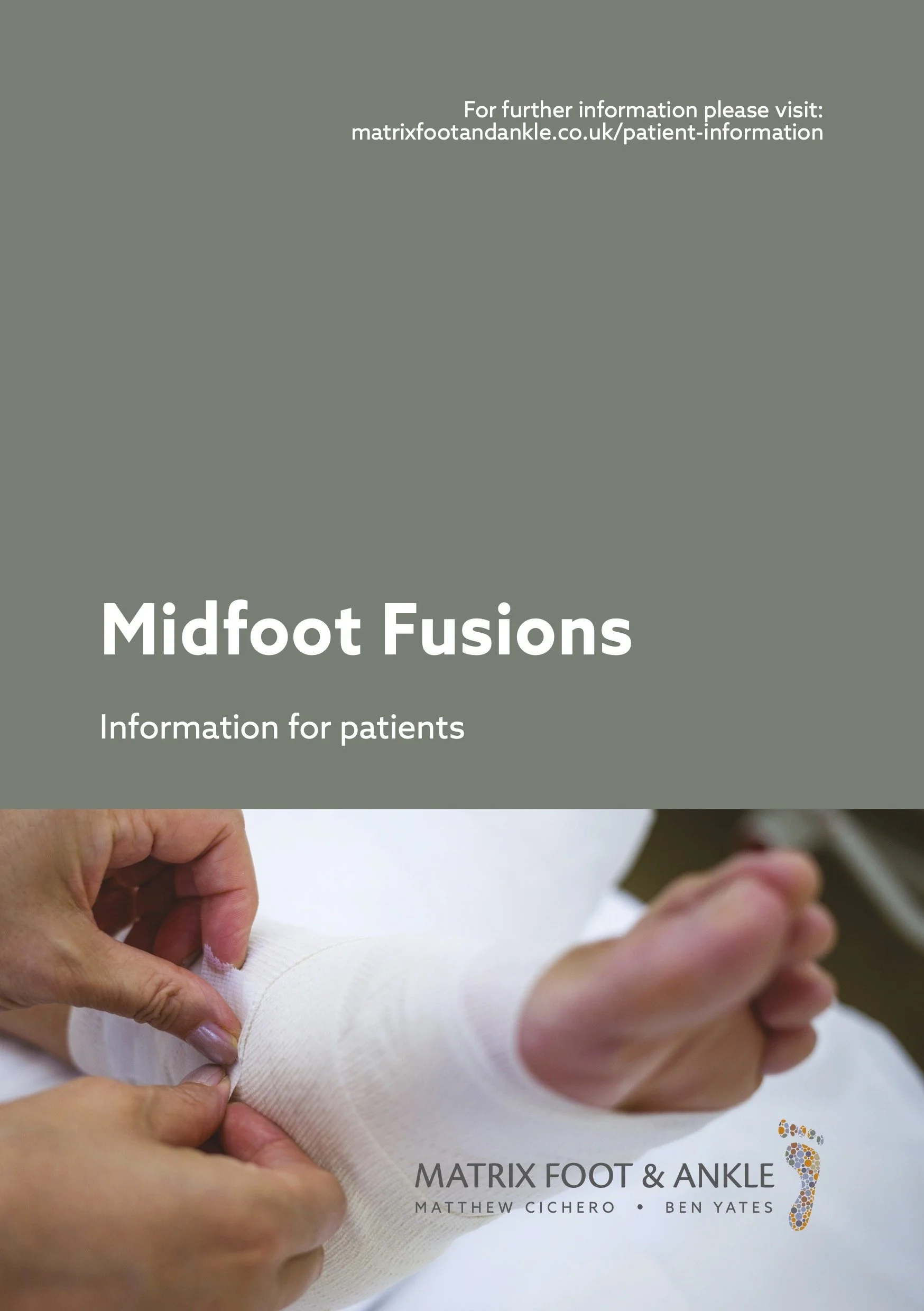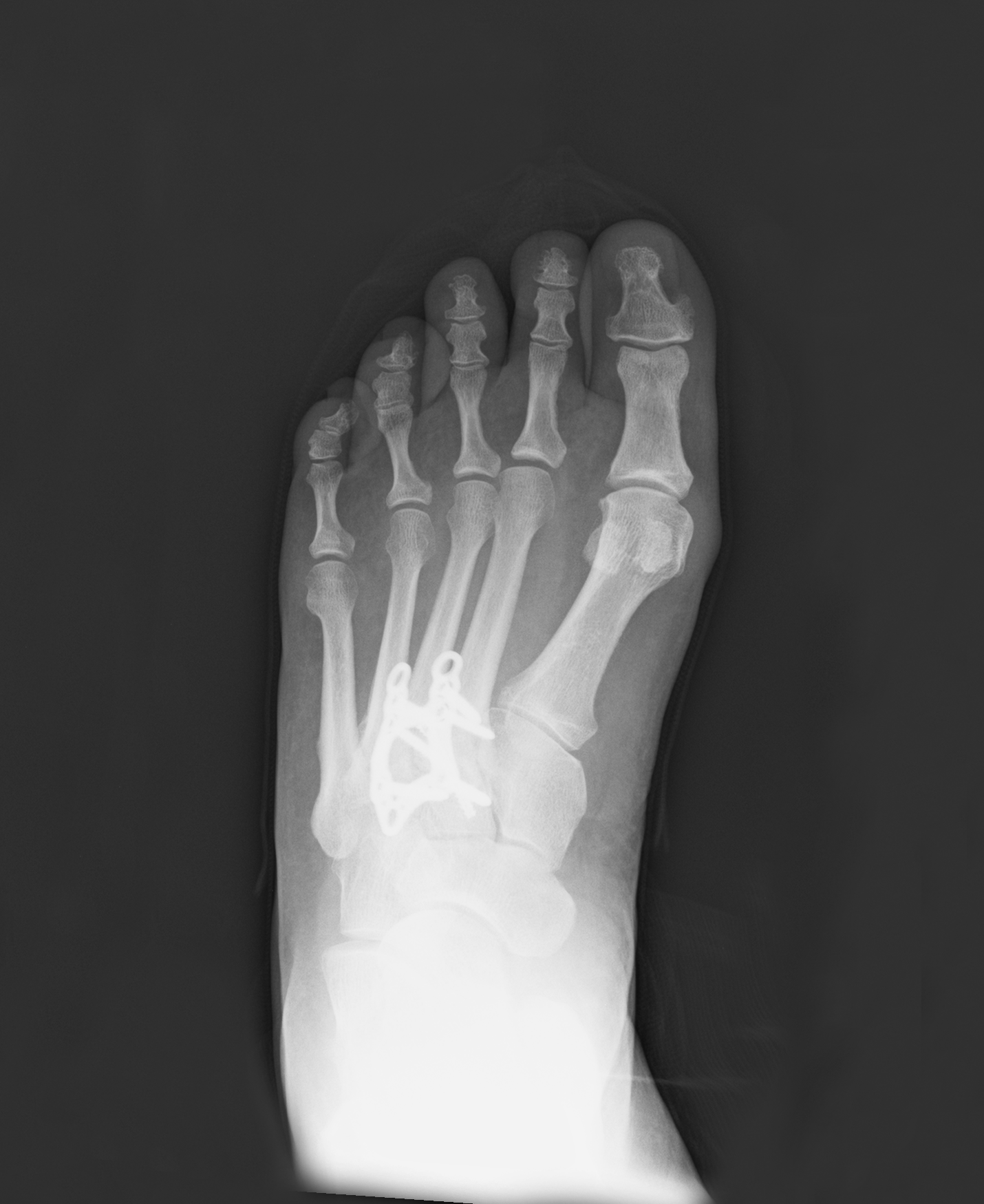Midfoot Fusions
Procedure
Midfoot Fusion(s)
Aims of surgery
To reduce pain and deformity due to arthritis in the middle part of the foot. This is an operation to “fuse” or stiffen either a single or multiple joints in the middle part of the foot. It fuses together two adjacent bones in the midfoot, which includes the navicular, cuneiform (medial, intermediate and lateral cuneiforms) and the metatarsal bones.
Advantages of this operation
Reduces pain and deformity.
Specific risks of this operation
Swelling of the foot — up to 9 months
Infection (2%)
Complications from bone graft harvest site (<5%) (if performed). Includes nerve injury, stress fracture and wound issues.
Chronic regional pain syndrome (<1%)
Transfer of pressure to the ball of the foot.
Non-union of bone (the bones do no knit together) (5–10%). Smokers are advised to stop smoking as the risk of this is higher in this patient group. Not all non-unions are painful or require further surgery.
Fixation problems (with the screws/plates/pins) (10–15%) which may require removal.
Nerve/tendon/blood vessel irritation/damage.
Deep Vein Thrombosis/Pulmonary Embolism (<1%)
Operation time
Usually about 90 minutes.
Incision placement/stitches
This will be on the top of the foot. If a bone graft is used, there may be an incision on the side of the foot near the heel. Absorbable stitches are used where possible.
Procedure
The bony surfaces either side of the joint are removed. The raw bone surfaces are then held together whilst they fuse (heal together). In some instances a piece of bone (graft) is inserted to help the healing and position. This may be taken from another part of the foot (usually the heel)
Fixation
Internal fixation (bone screws, plates or wires) are usually used.
You will not normally notice these and they do not usually need to be removed (<15%).
Will I have plaster?
Yes for about 4–6 weeks. A cam walker will be required for a further 2–4 weeks after the cast is removed.
Is this a day procedure?
Yes, you can usually go home the same day (you will usually be admitted for half a day).
Estimated time off work
Non-manual work approximately 8–10 weeks.
Manual work 10–12 weeks.
Indications for the procedure
Unstable or arthritic joint in the mid-foot area (lesser metatarso-cuneiform joint).
Alternative treatments
Manage your symptoms by altering activity levels, using painkillers and anti-inflammatories, extra depth/width shoes, rocker sole (stiff curved sole) using an insole or orthotic foot support, joint injection therapy.
More information
Speak with your consultant.
The operation is usually performed under a local anaesthetic block, which is achieved by either a series of injections around the ankle, or an injection behind your knee with sedation or general anaesthesia.
The operation takes about 90 minutes although you will be in the day surgery unit for some time before the surgery and afterwards, to allow you an opportunity to rest post-operatively. Your operated leg will be non weight-bearing in a cast for approximately 4 weeks and then in a walking cast for approximately a further 2–4 weeks. It is therefore very important that you have people to look after you and any dependants such as children, elderly or disabled relatives you have during this time.
Post-Operative Care
First 2–4 days after surgery
This is the time you are likely to have the most pain, but you will be given painkillers to help. You must rest completely for 2–4 days.
You will have a below knee cast and cannot put weight on the operated foot.
You will be able to stand and take weight on your non-operated foot after the operation, but you must rest with your feet up, as much as possible.
You should restrict your walking to going to the bathroom. When getting about, use your crutches in the way you will have been shown.
You can get about a little more after 3 days.
1–2 weeks after surgery
You will need to attend for your foot to be checked and, if necessary, recasted.
Between 4–6 weeks after surgery
You will have your foot x-rayed.
The cast will be removed if all is proceeding well and you will be allowed to start walking in a cam walker for a further 2–4 weeks.
Between 8–10 weeks after surgery
If all has gone well you will be able to start wearing a good lace-up shoe/trainer.
The foot will still be swollen and twinges of discomfort are not uncommon at this time due to your increasing activity. Your leg will feel naturally weak to start with as it has been in a cast.
You will be instructed regarding rehabilitation exercises or you may be referred to a physiotherapist.
You may return to non-manual work but may need longer if you have an active job.
You may return to driving if you can perform an emergency stop. You must check with your insurance company and Mr. Cichero before driving again.
Between 12–16 weeks after surgery
The foot should continue to improve and begin to feel normal again.
There will be less swelling.
Sport can be considered depending on your recovery.
6 months after surgery
You will have the final review between 3–6 months following surgery.
The swelling should now be slight and you should be getting the full benefit of the surgery.
12 months after surgery
The foot has stopped improving with all healing complete.
Please note, if a complication arises, recovery may be delayed.



